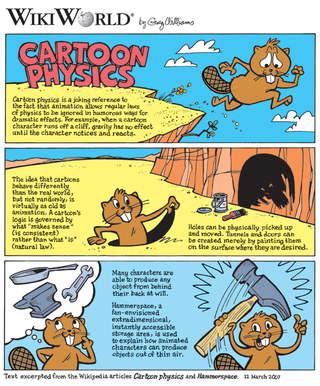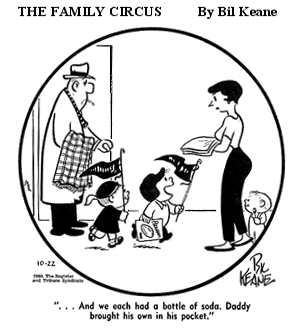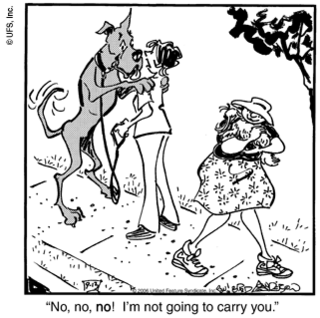
A comic strip is a sequence of cartoons, arranged in interrelated panels to display brief humor or form a narrative, often serialized, with text in balloons and captions. Traditionally, throughout the 20th and into the 21st century, these have been published in newspapers and magazines, with daily horizontal strips printed in black-and-white in newspapers, while Sunday papers offered longer sequences in special color comics sections. With the advent of the internet, online comic strips began to appear as webcomics.

A cartoon is a type of visual art that is typically drawn, frequently animated, in an unrealistic or semi-realistic style. The specific meaning has evolved, but the modern usage usually refers to either: an image or series of images intended for satire, caricature, or humor; or a motion picture that relies on a sequence of illustrations for its animation. Someone who creates cartoons in the first sense is called a cartoonist, and in the second sense they are usually called an animator.

Peanuts is a syndicated daily and Sunday American comic strip written and illustrated by Charles M. Schulz. The strip's original run extended from 1950 to 2000, continuing in reruns afterward. Peanuts is among the most popular and influential in the history of comic strips, with 17,897 strips published in all, making it "arguably the longest story ever told by one human being". At the time of Schulz's death in 2000, Peanuts ran in over 2,600 newspapers, with a readership of roughly 355 million across 75 countries, and had been translated into 21 languages. It helped to cement the four-panel gag strip as the standard in the United States, and together with its merchandise earned Schulz more than $1 billion. In 2015, a movie adaptation was released by Blue Sky Studios.

Comics are a medium used to express ideas with images, often combined with text or other visual information. It typically takes the form of a sequence of panels of images. Textual devices such as speech balloons, captions, and onomatopoeia can indicate dialogue, narration, sound effects, or other information. There is no consensus among theorists and historians on a definition of comics; some emphasize the combination of images and text, some sequentiality or other image relations, and others historical aspects such as mass reproduction or the use of recurring characters. Cartooning and other forms of illustration are the most common means of image-making in comics. Photo comics is a form that uses photographic images. Common forms include comic strips, editorial and gag cartoons, and comic books. Since the late 20th century, bound volumes such as graphic novels, comic albums, and tankōbon have become increasingly common, along with webcomics as well as scientific/medical comics.

The Family Circus is a syndicated comic strip created by cartoonist Bil Keane and, since Keane's death in 2011, written, inked and rendered (colored) by his son Jeff Keane. The strip generally uses a single captioned panel with a round border, hence the original name of the series, which was changed following objections from the magazine Family Circle. The series debuted February 29, 1960, and has been in continuous production ever since. According to publisher King Features Syndicate, it is the most widely syndicated cartoon panel in the world, appearing in 1,500 newspapers. Compilations of Family Circus comic strips have sold more than 13 million copies worldwide.

Alley Oop is a syndicated comic strip created December 5, 1932, by American cartoonist V. T. Hamlin, who wrote and drew the strip through four decades for Newspaper Enterprise Association. Hamlin introduced a cast of colorful characters and his storylines entertained with a combination of adventure, fantasy, and humor. Alley Oop, the strip's title character, is a sturdy citizen in the prehistoric kingdom of Moo. He rides his pet dinosaur Dinny, carries a stone axe, and wears only a fur loincloth.

Life in Hell is a comic strip by Matt Groening that was published weekly from 1977 to 2012. Its main characters include anthropomorphic rabbits and a gay couple. The comic covers a wide range of subjects, such as love, sex, work, and death, and explores themes of angst, social alienation, self-loathing, and fear of inevitable doom. The Simpsons began development as an animated adaptation for a segment of The Tracey Ullman Show, before Groening decided to adapt his character archetypes as original characters to avoid a loss of ownership rights to publish Life in Hell.

Henry is a comic strip created in 1932 by Carl Thomas Anderson. The title character is a young bald boy who is mostly mute in the comics. Except in a few early episodes, when the comic strip character communicates, he does so largely but not entirely through pantomime. He also spoke in a comic book series of 1946–1961 and in at least one Betty Boop cartoon from 1935 in which Betty Boop has a pet shop and Henry speaks to a dog in the window.

Marmaduke is a newspaper comic strip revolving around the Winslow family and their Great Dane, Marmaduke, drawn by Brad Anderson from June 1954 to 2015.

Speech balloons are a graphic convention used most commonly in comic books, comics, and cartoons to allow words to be understood as representing a character's speech or thoughts. A formal distinction is often made between the balloon that indicates speech and the one that indicates thoughts; the balloon that conveys thoughts is often referred to as a thought bubble or conversation cloud.
A daily strip is a newspaper comic strip format, appearing on weekdays, Monday through Saturday, as contrasted with a Sunday strip, which typically only appears on Sundays. They typically are smaller, 3–4 grids compared to the full page Sunday strip and are black and white.
Los Angeles Reader was a weekly paper established in 1978 and distributed in Los Angeles, United States. It followed the format of the (still-active) Chicago Reader. The paper was known for having lengthy, thoughtful reviews of movies, plays and concerts in the L.A. area.

DumbLand is a series of eight animated shorts written, directed and voiced by director David Lynch in 2002. The shorts were originally released on the Internet through Lynch's website, and were released as a DVD on March 28, 2006. The total running time of all eight shorts combined is approximately a half-hour.
Belvedere is a single panel comic strip created by George Webster Crenshaw which ran from June 18, 1962 to 1995. The star of the strip is a white dog with black spots. As of at least 2009, reprints of the strip were distributed by Johansen International Features.

The Strange World of Mr. Mum was a surreal humor comic panel by Irving Phillips which was published from May 5, 1958, to 1974. At its peak, it appeared daily in 180 newspapers in 22 countries. Initially distributed by the Hall Syndicate, it was later handled by the Field Newspaper Syndicate. A Sunday edition began October 4, 1959.
Jay Allen Sanford is an American author and cartoonist best known for his work with Revolutionary Comics, Carnal Comics, and Pacific Comics. He began writing the comic book Rock ‘N’ Roll Comics in 1989 as of the title's second issue, and still oversees the rock comic reprints published by Bluewater Productions and others. The publishing company he co-founded, Carnal Comics, is best known for launching the movie and cartoon character Demi the Demoness. Sanford ran Carnal Comics from 1994 through 2000, before handing over the publishing reins to SS Crompton.
Comics has developed specialized terminology. Several attempts have been made to formalize and define the terminology of comics by authors such as Will Eisner, Scott McCloud, R. C. Harvey and Dylan Horrocks. Much of the terminology in English is under dispute, so this page will list and describe the most common terms used in comics.
Quincy is an American syndicated newspaper comic strip published from July 13, 1970 to October 4, 1986, created and produced by cartoonist Ted Shearer. The series, about an African-American boy being raised by his grandmother in Harlem, was one of the earliest mainstream comic strips to star an African American in the lead role, following Dateline: Danger! (1968-1974) and Luther (1969-1986). Another predecessor, Wee Pals, features an African-American among an ensemble cast of different races and ethnicities.

Roger Rabbit is a fictional animated anthropomorphic rabbit. The character first appeared in author Gary K. Wolf's 1981 novel, Who Censored Roger Rabbit?. In the book, Roger is second banana in a popular comic strip, "Baby Herman". Roger hires private detective Eddie Valiant to investigate why his employers, the DeGreasy Brothers, have reneged on their promise to give Roger his own strip. When Roger is found murdered in his home, Valiant sets out to look for the killer, with the help of Roger's "doppel".

Cheval Noir was a black-and-white anthology comic book published between 1989 and 1994 by Dark Horse Comics. First edited by Dark Horse founder Mike Richardson, Cheval Noir aimed to showcase the best work by international creators to the English-speaking audience.















